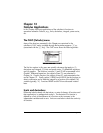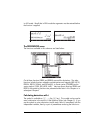
Page 13-3
To calculate one-sided limits, add +0 or -0 to the value to the variable. A “+0”
means limit from the right, while a “-0” means limit from the left. For example,
the limit of as x approaches 1 from the left can be determined with the
following keystrokes (ALG mode):
‚N~„l˜$OK$ R!ÜX-
1™@íX@Å1+0`
The result is as follows:
Derivatives
The derivative of a function f(x) at x = a is defined as the limit
Some examples of derivatives using this limit are shown in the following screen
shots:
Functions DERIV and DERVX
The function DERIV is used to take derivatives in terms of any independent
variable, while the function DERVX takes derivatives with respect to the CAS
default variable VX (typically ‘X’). While function DERVX is available directly in
the CALC menu, both functions are available in the DERIV.&INTEG sub-menu
within the CALCL menu ( „Ö).
Function DERIV requires a function, say f(t), and an independent variable, say, t,
while function DERVX requires only a function of VX. Examples are shown next
1−x
h
xfhxf
xf
dx
df
h
)()(
lim)('
0
−+
==
>−


















